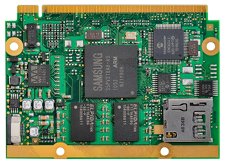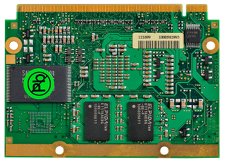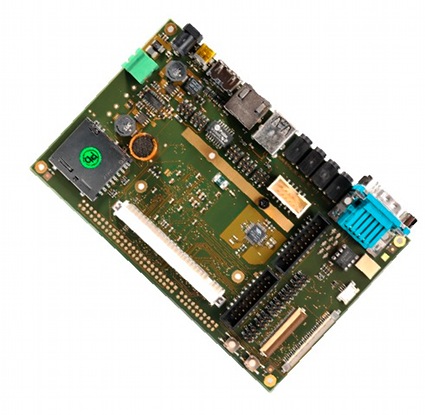‘nanoRISC’ module offers 1GHz speed and multiple video outputs
Sep 29, 2011 — by LinuxDevices Staff — from the LinuxDevices Archive — 6 viewsMSC Vertriebs announced a 2.75 x 2-inch SOM (system on module) packing a 1GHz Samsung S5PV210 processor, up to 1GB of RAM, and up to 4GB of flash storage. The nanoRISC-S5PV210 offers 10/100 Ethernet, USB 2.0 host and client ports, multiple serial ports, plus RGB, HDMI, and TV graphics interfaces, according to the company.
Stutensee, Germany-based MSC Vertriebs announced its nanoRISC format at March's Embedded World show, although we were unaware of it at the time. This SOM design resembles Qseven — which MSC had employed in February for its Tegra 2-based MSC Q7-NT2 — and appears to employ the same 230-pin MXM (Mobile PCI Express Module) connector, but it's even smaller: Qseven modules measure approximately 2.75 x 2.75 inches (70 x 70mm), whereas nanoRISC modules are 2.75 x 2.0 inches (70 x 50mm).
According to MSC, its initial nanoRISC-S5PC100 module employed Samsung's ARM Cortex A8-based S5PC100 processor, clocked at either 667MHz or 833MHz. The new nanoRISC-S5PV210 (below) steps up to — you guessed it — Samsung's S5PV210, getting a clock speed bump to either 800MHz or 1.0GHz.


The nanoRISC-S5PB210, top (left) and bottom (right)
(Click either to enlarge)
Apart from the upward tick in raw performance, this gives the nanoRISC-S5PV210 the ability to support higher screen resolutions, according to MSC. The earlier version of the module provided RGB resolutions up to 1280 x 720 pixels and HDMI resolutions to 720p (1280 x 720), but the nanoRISC-S5PV210 offers 1366 x 768 via RGB and 1080p (1920 x 1080) via HDMI, the company says.
The nanoRISC-S5PV210 otherwise has all the same capabilities as before, though its soldered-on DDR2 RAM is now offered in sizes up to 1GB. The module again includes up to 4GB of onboard flash, and its microSD slot accepts cards up to 32GB in size, according to MSC.
Naturally, the little module's interfaces all need the assistance of an application-specific baseboard to reach the outside world. MSC offers its own evaluation baseboard known as the nanoRISC-MB2 (detailed later in this story).
According to MSC, the nanoRISC-S5PV210's interfaces include not only the RGB and HDMI outputs we've already alluded to, plus an analog TV output that supports NTSC, PAL, composite, and S-Video connections. Also available are 10/100 Ethernet, a USB 2.0 host port, a USB 2.0 host/client port, a camera interface, and audio (S/PDIF, AC '97, and I2S), the company says.
MSC adds that the nanoRISC-S5PV210 further provides two serial ports, two SPI interfaces, two I2C interfaces, and a CAN 2.0B interface. The module is also said to include a four-wire resistive touch controller and an LED backlighting interface.
Typical power consumption is around 2.5 Watts, according to MSC. The module may be operated on 5VDC supplied by an AC adapter or USB, or 3VDC provided by a single lithium cell, the company adds.
Specifications listed by MSC for the nanoRISC-S5PV210 include:
- Processor — Samsung S5PV210 clocked at 800MHz or 1GHz
- Memory — up to 1GB of soldered-on DDR2 DRAM and 4GB of soldered-on NAND flash
- Expansion — microSD slot onboard; 1 x MMC/SD interface
- Networking — 10/100 Ethernet
- Other I/O:
- RGB
- HDMI
- analog video (NTSC, PAL, composite, S-Video)
- camera interface
- USB 2.0 host
- USB 2.0 host/client
- audio (AC '97, I2S, S/PDIF)
- 2 x serial
- 2 x SPI
- 2 x I2C
- CAN 2.0B
- Power — 2.5 Watts; 5VDC or 3VDC
- Operating range:
- 32 to 140 deg. F (commercial version)
- -40 to 185 deg. F (industrial version)
- Dimensions — 2.75 x 2.0 inches
nanoRISC-MB2 evaluation board
As mentioned, MSC provides an off-the-shelf baseboard so that nanoRISC customers can test the modules and begin their own hardware and software development. The nanoRISC-MB2, pictured below, measures 6.3 x 3.9 inches, giving it room for the module as well as a number of real-world connectors.

MSC's nanoRISC-MB2
Atop the board, there's an SD slot as well as headers for LVDS, RGB, and camera interfaces. The nanoRISC-MB2's coastline, meanwhile, is said to offer USB host (Type A) and On-The-Go (Mini USB) connectors, two DB9 serial connectors, an RJ45 Ethernet port, a DB9 CAN port, and 3.5mm audio jacks.
According to MSC, the nanoRISC-MB2 accepts input power ranging from 8 to 24VDC. Operating range matches that of the nanoRISC module itself, in either commercial or industrial versions.
Further information
MSC Vertriebs did not provide pricing or availability specifics, but noted that the nanoRISC S5PV210 is compatible with either Linux or Windows CE. More information may be found on the company's nanoRISC product page.
Jonathan Angel can be reached at [email protected] and followed at www.twitter.com/gadgetsense.
This article was originally published on LinuxDevices.com and has been donated to the open source community by QuinStreet Inc. Please visit LinuxToday.com for up-to-date news and articles about Linux and open source.